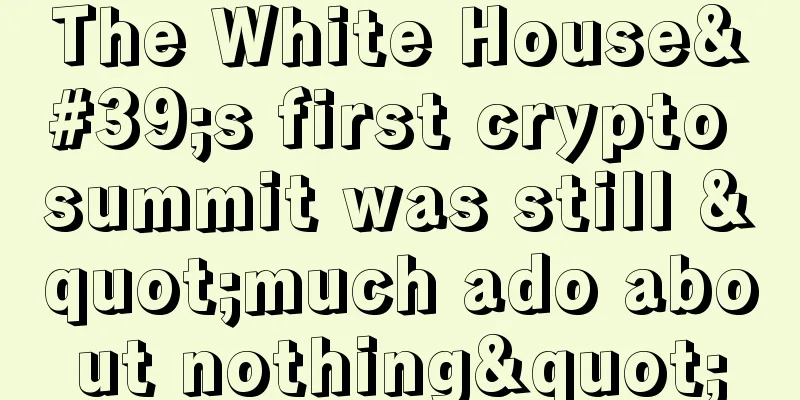The White House's first crypto summit was still "much ado about nothing"

|
In the early morning of March 8, 2025, the White House held its first encryption summit. Trump repeated the executive order on crypto asset reserves signed earlier at the summit, and said that the Treasury Department and the Commerce Department will explore new ways to accumulate more Bitcoin for reserves, provided that taxpayers do not pay any price. It ordered federal agencies to inventory the crypto assets currently held by the US government and determine how to transfer them to the Treasury Department to be kept in a new US crypto asset reserve. According to a list disclosed by FOX Business reporter Eleanor Terrett, the participants of the first White House Crypto Summit include:
Since this meeting was a closed-door meeting and not broadcast live to the public, participants in the White House Encryption Summit took turns speaking in the limited live broadcast information that was displayed to the public, but most of them were praises for a series of developments in the encryption field since Trump took office, as well as praise for Trump himself. U.S. Treasury Secretary Scott Bessant spoke about establishing a strategic Bitcoin reserve and crypto asset inventory, "regulation for crypto assets," and a federal framework for stablecoins, and said the Treasury will work closely with the IRS and the Office of the Comptroller of the Currency (OCC) to "revoke and modify" guidance that has harmed the ability of crypto asset companies to do business in the United States. Trump said he expects the House and Senate to pass stablecoin legislation “before the August recess.” Show more than substanceJudging from the key points of the summit, the Trump administration and the participants, as always, released a lot of grand declarations to the outside world, such as the United States will become a cryptocurrency center, establish a digital version of gold reserves, and end hostile policies against the crypto industry. It seems to have given a very ambitious blueprint. However, behind these bold words, the actual policy details are still unclear, especially in terms of stablecoin legislation, banking compliance access, and crypto asset taxation. No definite timetable or implementation path has been given. But for the market, the most important expectation of this summit is not grand slogans such as "The United States will become the center of encryption", but whether we can actually see specific and feasible implementation plans. Although the Trump administration has repeatedly declared that it is pro-encryption, if it cannot provide corresponding legislative, regulatory and enforcement details, the policy dividends expected by the market will still remain on paper. In other words, after repeatedly promoting the "pro-crypto" policy slogan, whether supporting measures can be actually introduced is the real core of the market's attention. The current industry's demand for a clear and stable regulatory environment is becoming more and more urgent. It is for this reason that the industry has high expectations for this summit. Judging from the current situation, the results of the summit are more at the level of political statements, lacking substantive content to further promote the implementation of policies. Therefore, despite the gathering of many bigwigs and senior regulators, the first crypto summit at the White House still presented a situation of "show over substance". Trump's pro-crypto attitude is more of a political operation. He showed his support in a high-profile and enthusiastic way, but avoided and delayed the key regulatory issues that really affect the industry's prospects. The speeches of many participants on the scene seemed enthusiastic, but in fact, most of them were just flattering or echoing Trump's political tone, which made the key issues that really need to be discussed, such as compliance, taxation, and market order, be covered up in the noisy flattery. In other words, although the summit was "loud and loud", it was more like a political statement or a political show, using the summit to create public opinion and momentum, and was far from being a real shaping of the crypto regulatory landscape. ADA, SOL, and XRP are only mentioned because they are ranked in the top five by market capitalizationInterestingly, according to the White House announcement, the executive order signed by Trump includes two parts: crypto strategic reserves and inventory. The strategic reserve will only contain BTC (the digital asset with the largest value storage), using about 200,000 tokens held by the government through criminal and civil forfeiture over the years. The other is a digital asset reserve that includes assets other than Bitcoin, perhaps XRP, ADA, ETH, and SOL (which the President announced last weekend) and possibly others. The key difference between a reserve and a stockpile is that the government will not actively look for ways to buy more of the assets in the stockpile. The government will only explore using government funds (if they can find a budget-neutral way to do it) to purchase BTC. The Secretary of the Treasury may determine responsible management strategies, including the possible sale of assets from the U.S. digital asset stockpile. In an exclusive interview with David Sacks by Bloomberg before the meeting, the crypto czar responded to the question, "Will ADA, SOL, and XRP be included in the US cryptocurrency reserves, and why did the president mention them?" He said, "Well, the president mentioned the top five cryptocurrencies by market value. So I think people are over-interpreting this. He just mentioned the top five that we actually hold." It emphasized, "Again, we need to do an accounting (referring to the United States will begin auditing existing cryptocurrency holdings). Today we are not sure whether the federal government owns these other altcoins. We know that the government owns Bitcoin. I believe the government also owns some Ethereum. As for the others, I am not so sure. This is why we need to do an accounting. Frankly speaking, no one has been able to give a clear answer as to what assets the federal government owns. Part of the problem is that we had no crypto asset strategy at all before this. That's why we missed the opportunity to accumulate a lot of value for the American people." Recently, Cardano founder Charles Hoskinson also said that he was not aware of Trump's plan to include ADA in the strategic reserve. "We knew nothing about ADA being included in the strategic reserve, which is news to me. We never even knew about it, and no one even talked to us about it." It can be seen that the concept of crypto strategic reserves and crypto asset inventory within the US government is still at the stage of unformed policy ideas and public opinion declarations. The government has no clear official accounting and regulatory planning for the actual holdings of these altcoins, management strategies, or even whether they will be included in the strategic reserves themselves. The so-called government owning the top five market value assets is more like an ambiguous external statement, or it may just be an example mentioned in political discourse. In this process, the Trump administration wants to send a strong signal that we are seriously building a crypto asset reserve system to highlight its pro-crypto stance, but on the other hand, it lacks a refined institutional arrangement for the current status of holdings and future purchase plans. David Sacks also admitted that the scale of altcoin holdings still needs to be audited and sorted out, and the compliance and accounting systems of various departments within the government and even between the federal and state governments are not fully prepared to accept such assets. This has led to an embarrassing situation. The official high-profile announcement of the layout of crypto assets, but the market found that the relevant information lacked substantive transparency, and even the founders of the project were unaware of being included in the reserve. In response, SOL fell 9% in a short period of time, with a minimum of around $137, and ADA and XRP both fell by about 7%. In addition, according to Decrypt, David Sacks said in an interview that Trump’s personal encryption projects (such as controversial meme coins) have “nothing to do” with government policies. When asked whether Trump’s cryptocurrency project affects industry regulation, he said: “I don’t think it has any impact. It has nothing to do with our work here.” When asked about Trump's "personal investment" in crypto assets such as Bitcoin, David Sacks said "these are facts without evidence." summaryThe current situation of crypto regulation in the United States is at a delicate stage where it urgently needs to take the lead externally, but cannot reach a clear consensus internally due to political games. This has created a huge contrast between the lofty rhetoric of this summit and the implementation of substantive policies. If the government continues to use crypto policy as a political tool in this way, rather than coordinating in depth with the industry, regulators and Congress, the drama of "much ado about nothing" will probably continue to unfold, and the policy dividends that can truly bring long-term stability and compliance development to the industry will still be hard to see. |
<<: Operation DOGE: How Musk used an unofficial team to influence the White House
Recommend
Bitmain's E3 Ethereum mining machine has a 6-fold drop in computing power and is expected to stop mining in April
According to BlockBeats, according to a report re...
What does it mean to have no evil bones in the head? What is the best shape of the skull?
The shape of a person's skull often determine...
IPFS Official @ You | 115th Weekly Report
IPFS Weekly 115 115th Statement: The article cont...
Why is it said that if you hurt your eyebrows, you will be rich and powerful?
Why is it said that if the eyebrows are damaged, ...
The General Office of the State Administration of Radio and Television issued a series of white papers on the application of blockchain technology
Source: Science and Technology Department Radio a...
Special gossip: the face that knows everything is popular recently
Many people stay at home and have no idea what is...
The face of a man with evil intentions
The face of a man with evil intentions In real li...
Cambridge University releases new tool to track Bitcoin's global computing power, with China accounting for 65% of the computing power
According to BlockBeats, a team from the Universi...
Are people with many forehead wrinkles loyal?
No matter what you do, people who are fickle are ...
What does a black forehead indicate? What will happen if a black forehead appears?
In fact, we don’t need anyone to tell us specific...
What does a mole on the chin mean? Does it mean good fortune?
Want to know more articles and content related to...
Crypto miners' "thrilling" August in depth
Author: 0x66, BlockBeats For crypto miners, 2020 ...
Face analysis of women's moles
Women all like smooth, delicate and flawless face...
Men who don't care about their wives
Men who don't care about their wives 1. Like ...
What kind of wife is the most difficult to support?
Recently, there is a saying circulating among men...









